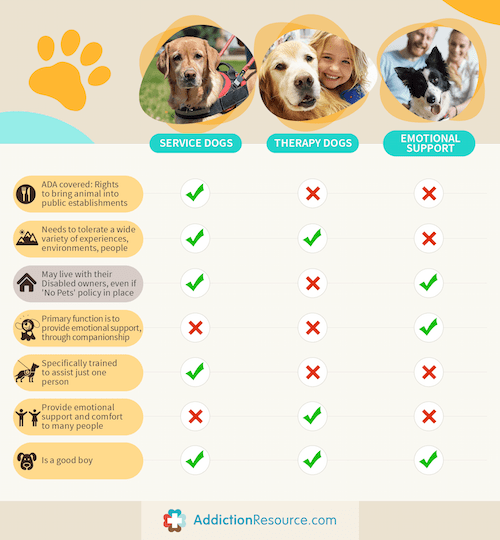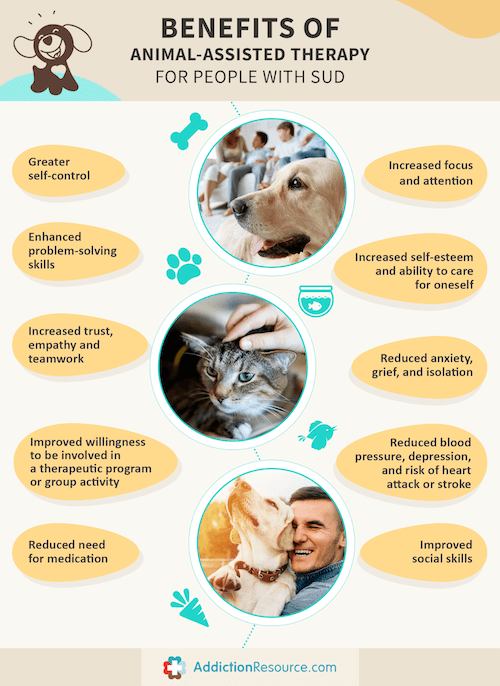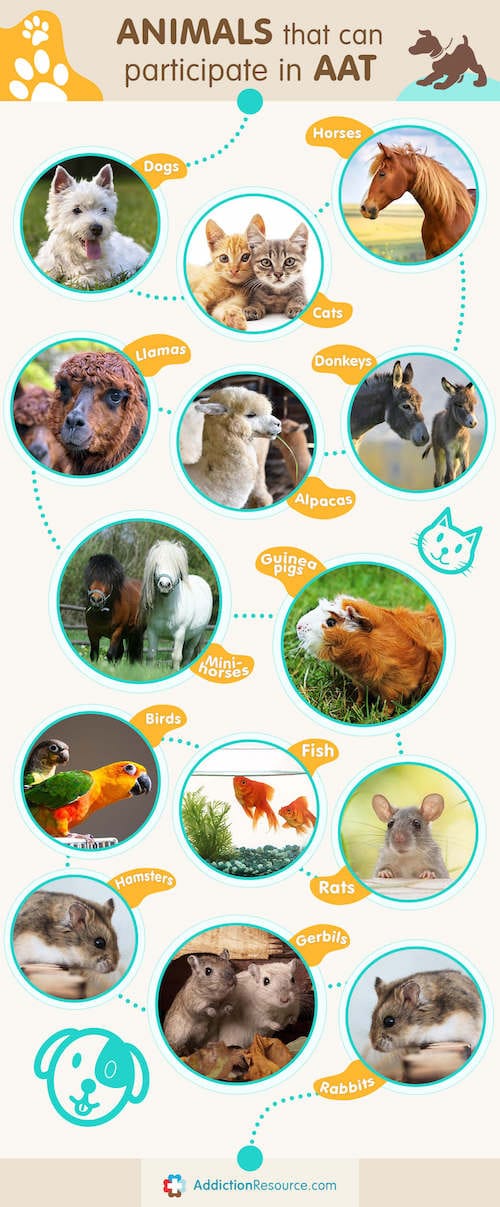Animals are not only our furry friends - they can help recovering addicts and even save lives. Addiction counselors and support staff are using animals more often to help patients. The comfort animals provide can be indispensable during treatment.
Table of Contents:
- What Is Animal-Assisted Therapy?
- What Are the Benefits of Animal-Assisted Therapy?
- The Process of Animal-Assisted Therapy
- What Animals Are Used in Animal-Assisted Therapy?
- Pets Within the Home
- How to Know if Animal-Assisted Therapy Is the Right Choice
What Is Animal-Assisted Therapy?
Animal-assisted therapy is generally understood as medical care where animals help patients heal, both mentally and physically. Sometimes the animal is trained specifically for therapy. In other cases, even if the animal isn't specifically trained, just its presence in the room helps the patient.
Within animal-assisted therapy, the involvement of the animal varies from case to case. In some cases, the animal just offers distraction. In others, it relieves anxiety and gives the patient a sense of security. The more involved the role of the animal is, the more likely the animal is to have been bred and trained for the job.
It is important to distinguish between animal-assisted therapy and companion animals or service animals within the home:
- Animal-assisted therapy is guided by a licensed and trained professional, who uses the animal as a tool. The process is goal-oriented, planned in advance, and structured. The animals are kept by their handlers and only interact with patients for a brief period each day.
- Companion animals, on the other hand, are animals that are kept by the person who needs them for comfort and support, and there may or may not be a therapist involved in the process. These animals are selected because they are good pets, not necessarily therapy animals.
- Service animals are those that are trained to help their owner in a specific manner, for example, guide dogs for the blind. They are selected based on their unique skills and ability to adapt to training.

What Are the Benefits of Animal-Assisted Therapy?
There are numerous benefits to animal-assisted therapy, the relationship they foster between the therapist and the patient being a major one. Recovering addicts often feel judged by others and insecure. Their lack of self-confidence is both a cause and effect of addiction. Animals do not judge. Being accepted by the therapy animal gives patients the chance to relax and begin to open up to their therapist.

Many people become addicted to drugs because they stimulate the release of endorphins, and the sudden lack of this stimulation can have devastating effects on the mental health of those entering recovery. This makes relapse more likely. Animal-assisted therapy also stimulates the release of endorphins, helping the patient transition to a life free of drugs.
Other benefits include:
- reduced anxiety and depression
- decrease in or elimination of problematic behaviors
- management of PTSD symptoms
The Process of Animal-Assisted Therapy
While the process of animal-assisted therapy may follow general guidelines, therapists are free to modify their approaches to ensure that their patients receive the right kind of care. Harvard Health outlines the following steps:
- The animal is introduced to the patient
- The patient interacts with the animal to start forming a bond
- The animal is taken away
- In the following session, the animal is brought back
- The patient interacts with it again, this time more directly
The interactions may be directed by the therapist—outlining specific activities to do with the animal—or the patient. Even the animal can lead. Interactions usually last less than an hour, though sometimes longer depending on the program designed by the therapist.
- If it delivers positive results, the animal may be brought to therapy every time
- As the patient is “weaned” off their need for that support, the animal is used less and less often
The goal is to get the patient to the point where they are able to cope well on their own, setting them up for success in recovery.
What Animals Are Used in Animal-Assisted Therapy?
Dogs immediately come to mind, more specifically golden retrievers, but they are far from the only animals used in this form of therapy. This is important, given that not everyone in need of therapy likes dogs.

There are certain types of animals that should not be used in therapy, namely those that are caught in the wild as well as animal species that are not considered domesticated. This means that animals like monkeys, elephants, and dolphins are excluded from animal-assisted therapy.
Below are some of the most common animals used in animal-assisted therapy.
Dog Therapy
For many patients, dogs are the ideal animals for animal-assisted therapy. Most people are familiar and comfortable with dogs, and they tend to be outgoing, happy, and excited to be around new people.
One can use nearly any dog breed for therapy, but that is not to say that all dogs are well-suited. Therapists evaluate dogs based on their temperament, age, personality, and other key factors. After that, they are trained to react in specific ways depending on the situation.
What does dog therapy look like? It depends on the patient, therapist, and facility. Common activities in dog therapy include:
- Feeding the dog
- Speaking to the dog
- Speaking to the therapist while holding the dog
- Grooming and petting the dog
- Taking part in training the dog
- Playing with the dog
- Walking the dog
In traditional animal-assisted therapy sessions, the patient only works with the dog for a short period of time each day and every few days, and these sessions often become a highlight of their rehabilitation.
Cat Therapy
Cats are a less obvious choice for a therapy animal. Even with training, they won’t do exactly what you want them to do always. This slight unpredictability might make them seem as though they are not suited to therapy use. However, research has found that having a cat around improves one’s mood by releasing serotonin. When this happens, the patient is better able to cope with stress and anxiety.
As with dogs, nearly all breeds of cats can be used as therapy animals, but cats will be selected based on their temperament and personalities and then go through training to ensure that they are suited to the work they will be required to perform. Common activities used in cat therapy include:
- Speaking to the cat
- Speaking to the therapist while holding the cat
- Grooming and petting the cat
- Playing with the cat
Due to the nature of cats, they will have some degree of control over the session, like deciding they’ve had enough of a specific activity. They work great – if you’re a cat person.
Pets Within the Home
Therapy animals and pets may well differ, but pets can also benefit those suffering from addiction. More and more therapists and rehab centers are coming to understand just how big of an impact keeping a pet can have.
The Benefits of Having a Pet for Addicts
- Owning a pet gives the patient a sense of responsibility, motivating them to succeed
- Most pets require walking and playing which helps their owner get physically active, which helps overcome depression
- Pet owner communities are an excellent way to be social
- Most animals force their owners to keep a routine, which can help to keep a recovering addict on track
- Simply having an animal around can release brain chemicals similar to those released when using drugs, helping rewire the brain
Juggling Pet Ownership and Rehab
The problem with pet ownership and addicts attempting to enter into recovery is that not all rehabs accept pets. Some pet owners would rather forgo the care they need than part with their animal, even temporarily. Below are some steps to take, in brief:
- Look for a rehab that allows pets
- Ease the pet’s anxiety
- Check on the pet
- Find the right care
If you can’t find a rehab that allows pets, the next option is to work on easing the pet’s separation anxiety. One needs to look into ways to be able to check on their pet and/or interact with it. Some possibilities include pet cameras back home and weekly visits where their pet is brought to the rehab facility.
Of course, finding the right care for the animal is vital. Boarding facilities, pet sitters, and family and friends are all choices available to most patients. If none of these is an option, many animal rescues will take pets temporarily to help pet owners, often at little to no cost.
How to Know if Animal-Assisted Therapy Is the Right Choice
Ultimately, whether or not animal-assisted therapy is a good choice comes down to what the patient needs. If a patient is an animal person and feels better around pets, chances are high that they will benefit from it. If, on the other hand, they find animals distracting, it might be best to steer clear of such options. Obviously, a person who is afraid of dogs would not benefit from one in their recovery.
What is the best way to find out? Simply call a rehab center that offers animal-assisted therapy and talk to them about what the program involves.
About the author
Christine Nowak is content and editorial director at Addiction Resource. She works closely with universities and medical professionals to create the most useful content for the readers. Christine is also a volunteer for the Humane Society care centers and helps rescue the animals impacted by cruelty and natural disasters.
Was this article helpful?
Help us make our articles even better










